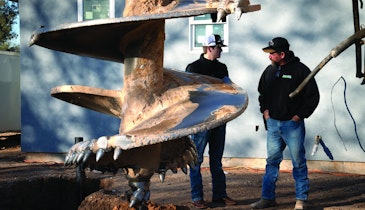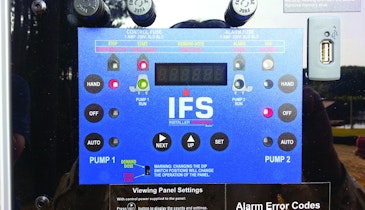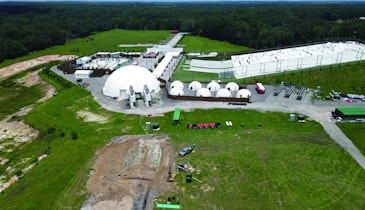Grizzly Bear Cabins and Campground in Denali, Alaska, needed a larger onsite system to handle a major expansion. Across the road, the undersized system for Denali River Cabins complex also needed replacement.
Bio-Microbics engineer Reza Shams, Ph.D. helped design engineer Bob Tsigonis, P.E., owner of Lifewater Engineering Co. in Fairbanks, to address numerous challenges. Both properties had potable wells and minimal space, ruling out new or replacement drainfields. Effluent discharging to the Nenana River had to meet stringent requirements.
“The systems operate May through September, so winter storage was an issue,” says Tsigonis. “We had to wait until the snow melted and the ground thawed to install them, leaving only a few weeks before the first guests arrived.”
His solution used ExtremeSTP sewage treatment plants from Lifewater Engineering. The units, designed to work on permafrost soils, use bioreactors and BioBarrier flat-plate membrane technology from Bio-Microbics Inc. to produce extremely high-quality effluent for environmentally sensitive areas.
Site conditions
The systems are above ground on compacted gravel pads. The sites are less than 500 feet from the Nenana River and next to Denali National Park.
System components
Tsigonis designed the Grizzly Bear system to handle 8,000 gpd and the DRC system to handle 24,000 gpd on completion of the complex.
The Grizzly Bear system’s major components are three 1,750-gallon dual-compartment plastic septic tanks with BioSTEP pump vault systems from Bio-Microbics,two 1,000-gallon dual-compartment plastic septic tanks in series with the BioSTEP system, and an 8,000-gallon ExtremeSTP plant with BioBarrier membranes in a 40-foot-long shipping container.
The Denali River Cabins system included a 500-gallon grease interceptor, 1,000-gallon plastic tank with BioSTEP system for the laundry and employee kitchen, an existing 12,000-gallon, two-compartment steel septic tank, and a 24,000-gallon ExtremeSTP plant in three side-by-side 40-foot-long containers.
Both systems have custom-built Web-based control systems from Lifewater Engineering.
System operation
Three of the new Grizzly Bear buildings have 1,750-gallon septic tanks. The fourth has the 1,000-gallon tanks. Wastewater flows by gravity into the primary settling compartment. Effluent passes through angled slots in the sides of two 4-inch-diameter SaniTEE effluent screens, travels up, and passes into the pump chamber through keyhole weirs. A water level sensor triggers the pump, transferring effluent through a 1.25-inch PVC pipe to the ExtremeSTP plant.
The plant has a two-compartment treatment tank in the rear of the container and a control room in front. The first compartment has a 10,000-gallon bioreactor with three LIXOR 1.0 aerators from Bio-Microbics. Regenerative blowers, one per module and one per aerator, send large volumes of air to the submerged aerators and mixing diffusers.
A venturi in the aerators breaks the incoming air stream into smaller bubbles, producing a vacuum that pulls in surrounding liquids. The turbulent plume creates horizontal and vertical mixing patterns.
The second treatment compartment has a BioBarrier High-Strength Membrane BioReactor 9.0 with four micro-filtration flat-sheet membrane modules that screen solids through pores of 0.03 to 1.1 microns. A piping system attached to each module transfers permeate to a tank in the control room.
An on-demand pump in the tank sends liquid through a UV disinfection unit discharging through a 4-inch HDPE pipe to the river. The total hydraulic retention time is 18 hours. “The membrane system meets the discharge permits for fecal coliform, so the UV units are merely backup,” says Tsigonis.
The grease interceptor in the Denali River Cabins system plumbs to the steel septic tank. Pumps in the two septic tanks deliver wastewater to the chamber with four 8-inch-diameter SaniTEE screens. They remove most stringy materials that could disrupt flow between the membrane plates.
Water then flows into the treatment plant’s first container housing a 10,000-gallon bioreactor. Three LIXOR 1.0 aerators mix the wastewater before it flows through a 6-inch pipe to an identical bioreactor in the third container. Between them is another container housing the equipment room and nine BioBarrier HSMBR 9.0 membrane modules. (The tanks will hold 18 modules when the facility is completed.)
Piping attached to each module transports permeate to a tank in the equipment room. A submersible pump in the second bioreactor transfers mixed liquor to the membrane tanks. To prevent TSS from rising too high in the tanks, the pump delivers a larger amount than the membranes can handle.
The excess mixed liquor overflows into the first bioreactor tank, then is piped to the second bioreactor tank in a closed-loop system through a 6-inch HDPE pipe. An on-demand pump runs about 100 times per day at peak capacity, sending 60 to 500 gallons through a 4-inch effluent line to the river. The total hydraulic retention time is 16 hours.
A programmable logic controller controls all equipment and logs operational data. A Web camera in the equipment room lets the Lifewater Engineering staff see what is happening. “Our server in Fairbanks automatically downloads the data and sends an alarm to our office and to three people’s cell phones if anything gets out of range,” says Tsigonis.
Installation
Components were assembled and tested in Fairbanks, then trucked 100 miles to the site. “The units were designed to be plug-and-play and ready to run,” says Tsigonis. “It took four to five days to commission each system after installation.”
Lifewater workers built the insulated bioreactor tanks from CNC router-cut thermoplastic sheets 5 by 10 feet by 0.25, 0.50 or 0.75 inches thick. They joined the precision pieces using extrusion welders to achieve mechanical strength and watertight joints. The copolymer polypropylene plastic does not corrode or need painting.
The membrane plates set into frames that formed the modules. The automated operation sequence includes rest periods for the membranes and requires no backwash. “The membranes are ruined if they dry out, so they stay in their tanks year-round,” says Tsigonis. “To prevent freezing, the resorts have redundant heating systems.”
Maintenance
Lifewater Engineering has maintenance contracts at both establishments. At the end of the tourist season, technicians pump and wash the bioreactor tanks and shut down the system. When the businesses open, technicians seed the units with sludge from a municipal treatment plant and start up the systems.
A technician draws monthly samples from the Denali River Cabins system while it is operational. Normally, the TSS level is undetectable, and the BOD is less than 3 mg/l. Regulations do not require measuring nitrogen. Lifewater remotely monitors the Denali River Cabins RC system year-round.





